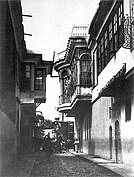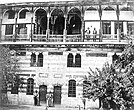|
Old city of Damascus
 The old city of Damascus (Arabic: دِمَشْق ٱلْقَدِيمَة, romanized: Dimašq al-Qadīmah) is the historic city centre of Damascus, Syria. The old city, which is one of the oldest continuously inhabited cities in the world,[1] contains numerous archaeological sites, including some historical churches and mosques. Many cultures have left their mark, especially Hellenistic, Roman, Byzantine and Islamic. In 1979, the historical center of the city, surrounded by walls of Roman era, was declared a World Heritage Site by UNESCO. In June 2013, UNESCO included all Syrian sites on the list of World Heritage in Danger to warn of the risks to which they are exposed because of the Syrian Civil War.[2] Origins and foundingLying on the south bank of Barada River, the ancient city was founded in the 3rd millennium B.C. The horizontal diameter of the oval is about 1.5 km (0.9 mi) which is known as Damascus Straight Street, while the vertical diameter (Latin: Cardus Maximus) is about 1 km (0.6 mi). With an approximate area of 86.12 hectares (212.8 acres; 0.86 km2), the ancient city was enclosed within a historic wall of 4.5 km (2.8 mi) in circuit that was mainly built by the Romans, then fortified by the Ayyubids and Mamluks.[2]  The first mentioning of Damascus was as "Ta-ms-qu" in the second millennium BC, it was situated in an Amorite region in the middle of a conflict zone between the Hittites and Egyptians. The city was tributary to these powers until the emergence of the Sea Peoples in 1200 BC whose raids helped in weakening the arch rivals. Consequently, the Semitic Arameans managed to establish the independent state of Aram-Damascus (11th century – 733 BC), naming the main city as ‘Dimashqu’ or ‘Darmeseq’.[3] Historical timelineThroughout its history, Damascus has been part of the following states:
Main sights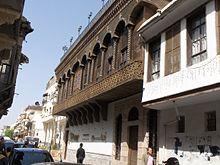 Damascus has a wealth of historical sites dating back to many different periods of the city's history. Since the city has been built up with every passing occupation, it has become almost impossible to excavate all the ruins of Damascus that lie up to 2.4 m (8 ft) below the modern level. The Citadel of Damascus is located in the northwest corner of the Old City. The Damascus Straight Street (referred to in the conversion of St. Paul in Acts 9:11), also known as the Via Recta, was the decumanus (east–west main street) of Roman Damascus, and extended for over 1,500 m (4,900 ft). Today, it consists of the street of Bab Sharqi and the Souk Medhat Pasha, a covered market. The Bab Sharqi street is filled with small shops and leads to the old Christian quarter of Bab Tuma (St. Thomas's Gate). Medhat Pasha Souq is also a main market in Damascus and was named after Midhat Pasha, the Ottoman governor of Syria who renovated the Souk. At the end of the Bab Sharqi street, one reaches the House of Ananias, an underground chapel that was the cellar of Ananias's house. The Umayyad Mosque, also known as the Grand Mosque of Damascus, is one of the largest mosques in the world and also one of the oldest sites of continuous prayer since the rise of Islam. A shrine in the mosque is said to contain the body of St. John the Baptist. The mausoleum where Saladin was buried is located in the gardens just outside the mosque. Sayyidah Ruqayya Mosque, the shrine of the youngest daughter of Husayn ibn Ali, can also be found near the Umayyad Mosque. The ancient district of Amara is also within a walking distance from these sites. Another heavily visited site is Sayyidah Zaynab Mosque, where the tomb of Zaynab bint Ali is believed to be located. Souqs and Khans
Historic buildings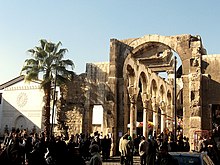 
Madrasas
Places of worshipMosques
Churches 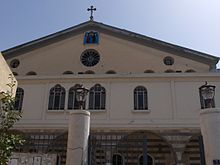
GatesThe old part of the city is surrounded with 4.5-kilometre-long (2.8-mile) thick walls,[13] pierced by the seven historical gates, the eighth gate was added later by Muslims. These are, clockwise from the north-east side:
HammamsThe presence of public baths (ḥammāms) in Damascus started during the Umayyad era, while some historians date them back to the Roman era. The Damascene baths were mentioned by a number of Damascus historians, such as Ibn 'Asakir (1106–1175 AD) in his famous book "The History of Damascus". In his book, Ibn 'Asakir named 77 of baths working at that time within the city. The historian Ibn Shaddad counted 114 baths located in Damascus in 1250 AD. The number of these baths increased to 365 during the Ottoman era, then decreased drastically to reach 60 baths in the late nineteenth century AD. Today, however, the number of baths in full operation is barely 20, the most famous of them is the "Nour al-Din al-Shahid" bath in the Al-Buzuriyah Souq.[14] Districts and subdivisions
Preservation of the ancient cityThreats to the future of the old City Due to the rapid decline of the population of Old Damascus (between 1995 and 2009 about 30,000 people moved out of the old city for more modern accommodation),[15] a growing number of buildings are being abandoned or are falling into disrepair. In March 2007, the local government announced that it would be demolishing Old City buildings along a 1,400 m (4,600 ft) stretch of rampart walls as part of a redevelopment scheme. These factors resulted in the Old City being placed by the World Monuments Fund on its 2008 Watch List of the 100 Most Endangered Sites in the world.[16][17] Current state of old DamascusIn spite of the recommendations of the UNESCO World Heritage Center:[18]
In October 2010, Global Heritage Fund named Damascus one of 12 cultural heritage sites most "on the verge" of irreparable loss and destruction.[20] The old city outside of the walls of the Roman era, is also considered part of the old Damascus, however, it hasn't been given the same historical priority. During the French mandate, Michel Écochard, the French architect, planned an urban scheme for the city, that advised to only reserve the parts of the old city inside the Roman walls. This approach has been adopted later by the ruling governments of Syria, which contributed to demolishing parts of its old neighborhoods. Old houses in Sarouja, Al Midan, and Shagour Barrani was replaced by new buildings for trade mainly.[21][22] See also
Wikimedia Commons has media related to Ancient City of Damascus. References
Bibliography
|
||||||||||||||||||||||||||||||


